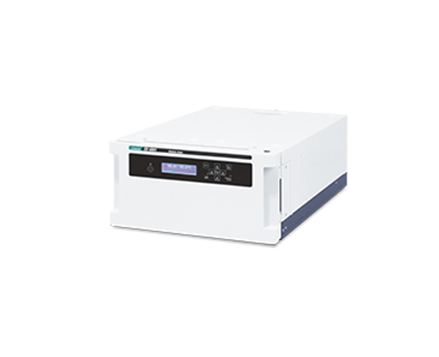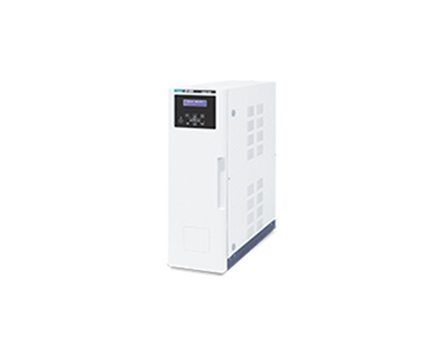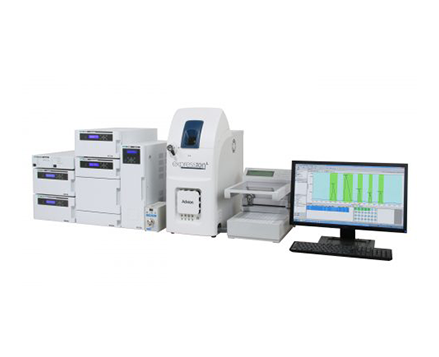Rapid Separation of a Tuberculosis Medication using UHPLC
January 5, 2024
Introduction
High speed HPLC separations have become increasingly important in a variety of different fields including pharmacology, food science, and agrochemistry. In general, conventional HPLC separations have been performed on columns packed with a stationary phase composed of 5 µm particles. By contrast, the X-LC Series UHPLC system uses shorter columns packed with smaller sub-2 µm particles. This application note details the analysis of a tuberculosis treatment composed of three compounds (rifampin ,isoniazid, and pyrazinamide) with a method outlined by USP(1) to compare the performance of UHPLC with conventional HPLC.
Experimental
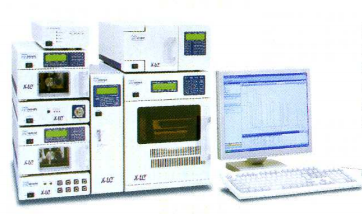
The conventional and rapid sample analyses described below were made using an integrated X-LC system configured for binary gradient with UV-visible detection.
Table 1. Analysis parameters
| Mobile Phase | A: 0.01 M Na2HPO4/CH3CN (96/4) (pH 6.8) |
| B: 0.01 M Na2HPO4/CH3CN (45/55) (pH 6.8) | |
| Wavelength | 238 nm |
| Sample | 0.16 mg/L Rifampin |
| 0.08 mg/L Isoniazid | |
| 0.43 mg/L Pyrazinamide | |
| (in 0.01M Na2HPO4/CH3OH (96/4)) |
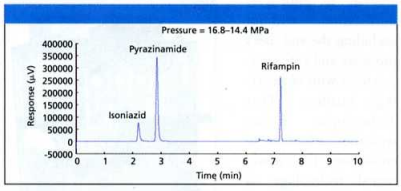
Figure 1 Separation of a 10 µL sample injection using conventional HPLC. A flow rate of 1.5 mL/min was used with a CrestPak C18S column, 5 µm particle size (4.6 mm i.d. X 150 mm L). The analysis time was 9 min.
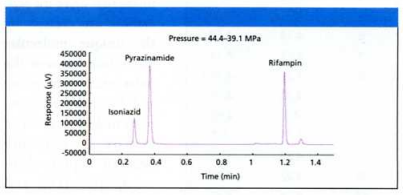
Figure 2 Separation of a 1 µL sample injection using UHPLC. A flow rate of 0.8 mL/min, nearly half that of the HPLC separation, was used for elution of the sample using an X-PressPak C18S column with 2 µm particles (2.1 mm i.d. X 50 mm L). This resulted in an analysis time of 1.3 min, approximately 7 times faster than the HPLC separation. The gradient elution program of 1.5 min is 10 times shorter than that for HPLC.
Table II Comparison between UHPLC and conventional HPLC.
Table 2. Comparison between UHPLC and conventional HPLC.
| Pyrazinamide (Peak #2) | HPLC (µm) | X-LC (µm) | X-LC/HPLC (µm) |
|---|---|---|---|
| Analysis Time (min) | 8 | 1.3 | 0.163 |
| Solvent (mL/analysis) | 30 | 1.6 | 0.053 |
| Peak Height (mAU) | 337 | 378 | 1.122 |
| Injection Volume (µL) | 10 | 1 | 0.1 |
Keywords
747006X
Conclusion
We have demonstrated that the X-LC system offers rapid separations, up to 10 times faster than that of conventional HPLC, with improved sensitivity and efficiency whilst reducing mobile phase solvent use. This more efficient technique is also completely scaleable from traditional HPLC methods providing an attractive option for a wide range of samples.
Featured Products:

Rapid Separation of a Tuberculosis Medication using UHPLC
Introduction
High speed HPLC separations have become increasingly important in a variety of different fields including pharmacology, food science, and agrochemistry. In general, conventional HPLC separations have been performed on columns packed with a stationary phase composed of 5 µm particles. By contrast, the X-LC Series UHPLC system uses shorter columns packed with smaller sub-2 µm particles. This application note details the analysis of a tuberculosis treatment composed of three compounds (rifampin ,isoniazid, and pyrazinamide) with a method outlined by USP(1) to compare the performance of UHPLC with conventional HPLC.
Experimental

The conventional and rapid sample analyses described below were made using an integrated X-LC system configured for binary gradient with UV-visible detection.
Table 1. Analysis parameters
| Mobile Phase | A: 0.01 M Na2HPO4/CH3CN (96/4) (pH 6.8) |
| B: 0.01 M Na2HPO4/CH3CN (45/55) (pH 6.8) | |
| Wavelength | 238 nm |
| Sample | 0.16 mg/L Rifampin |
| 0.08 mg/L Isoniazid | |
| 0.43 mg/L Pyrazinamide | |
| (in 0.01M Na2HPO4/CH3OH (96/4)) |

Figure 1 Separation of a 10 µL sample injection using conventional HPLC. A flow rate of 1.5 mL/min was used with a CrestPak C18S column, 5 µm particle size (4.6 mm i.d. X 150 mm L). The analysis time was 9 min.

Figure 2 Separation of a 1 µL sample injection using UHPLC. A flow rate of 0.8 mL/min, nearly half that of the HPLC separation, was used for elution of the sample using an X-PressPak C18S column with 2 µm particles (2.1 mm i.d. X 50 mm L). This resulted in an analysis time of 1.3 min, approximately 7 times faster than the HPLC separation. The gradient elution program of 1.5 min is 10 times shorter than that for HPLC.
Table II Comparison between UHPLC and conventional HPLC.
Table 2. Comparison between UHPLC and conventional HPLC.
| Pyrazinamide (Peak #2) | HPLC (µm) | X-LC (µm) | X-LC/HPLC (µm) |
|---|---|---|---|
| Analysis Time (min) | 8 | 1.3 | 0.163 |
| Solvent (mL/analysis) | 30 | 1.6 | 0.053 |
| Peak Height (mAU) | 337 | 378 | 1.122 |
| Injection Volume (µL) | 10 | 1 | 0.1 |
Conclusion
We have demonstrated that the X-LC system offers rapid separations, up to 10 times faster than that of conventional HPLC, with improved sensitivity and efficiency whilst reducing mobile phase solvent use. This more efficient technique is also completely scaleable from traditional HPLC methods providing an attractive option for a wide range of samples.
Keywords
747006X

 Download This Application
Download This Application